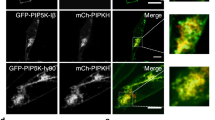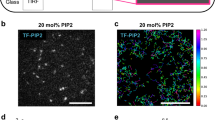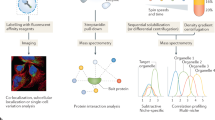Abstract
Phosphatase and tensin homolog (PTEN) is one of the most frequently mutated tumor suppressor genes in cancers. PTEN has a central role in phosphatidylinositol (3,4,5)-trisphosphate (PIP3) signaling and converts PIP3 to phosphatidylinositol (4,5)-bisphosphate at the plasma membrane. Despite its importance, the mechanism that mediates membrane localization of PTEN is poorly understood. Here, we generated a library that contains green fluorescent protein fused to randomly mutated human PTEN and expressed the library in Dictyostelium cells. Using live cell imaging, we identified mutations that enhance the association of PTEN with the plasma membrane. These mutations were located in four separate regions, including the phosphatase catalytic site, the calcium-binding region 3 (CBR3) loop, the Cα2 loop and the C-terminal tail phosphorylation site. The phosphatase catalytic site, the CBR3 loop and the Cα2 loop formed the membrane-binding regulatory interface and interacted with the inhibitory phosphorylated C-terminal tail. Furthermore, we showed that membrane recruitment of PTEN is required for PTEN function in cells. Thus, heterologous expression system in Dictyostelium cells provides mechanistic and functional insight into membrane localization of PTEN.
This is a preview of subscription content, access via your institution
Access options
Subscribe to this journal
Receive 50 print issues and online access
$259.00 per year
only $5.18 per issue
Buy this article
- Purchase on Springer Link
- Instant access to full article PDF
Prices may be subject to local taxes which are calculated during checkout







Similar content being viewed by others
References
Hollander MC, Blumenthal GM, Dennis PA . PTEN loss in the continuum of common cancers, rare syndromes and mouse models. Nat Rev Cancer 2011; 11: 289–301.
Carracedo A, Alimonti A, Pandolfi PP . PTEN level in tumor suppression: how much is too little? Cancer Res 2011; 71: 629–633.
Leslie NR, Dixon MJ, Schenning M, Gray A, Batty IH . Distinct inactivation of PI3K signalling by PTEN and 5-phosphatases. Adv Biol Regul 2012; 52: 205–213.
Rodon J, Dienstmann R, Serra V, Tabernero J . Development of PI3K inhibitors: lessons learned from early clinical trials. Nat Rev Clin Oncol 2013; 10: 143–153.
Vanhaesebroeck B, Stephens L, Hawkins P . PI3K signalling: the path to discovery and understanding. Nat Rev Mol Cell Biol 2012; 13: 195–203.
Baker SJ . PTEN enters the nuclear age. Cell 2007; 128: 25–28.
Song MS, Salmena L, Pandolfi PP . The functions and regulation of the PTEN tumour suppressor. Nat Rev Mol Cell Biol 2012; 13: 283–296.
Tamguney T, Stokoe D . New insights into PTEN. J Cell Sci 2007; 120 (Pt 23): 4071–4079.
Rahdar M, Inoue T, Meyer T, Zhang J, Vazquez F, Devreotes PN . A phosphorylation-dependent intramolecular interaction regulates the membrane association and activity of the tumor suppressor PTEN. Proc Natl Acad Sci USA 2009; 106: 480–485.
Walker SM, Leslie NR, Perera NM, Batty IH, Downes CP . The tumour-suppressor function of PTEN requires an N-terminal lipid-binding motif. Biochem J 2004; 379 (Pt 2): 301–307.
Denning G, Jean-Joseph B, Prince C, Durden DL, Vogt PK . A short N-terminal sequence of PTEN controls cytoplasmic localization and is required for suppression of cell growth. Oncogene 2007; 26: 3930–3940.
Lee JO, Yang H, Georgescu MM, Di Cristofano A, Maehama T, Shi Y et al. Crystal structure of the PTEN tumor suppressor: implications for its phosphoinositide phosphatase activity and membrane association. Cell 1999; 99: 323–334.
Das S, Dixon JE, Cho W . Membrane-binding and activation mechanism of PTEN. Proc Natl Acad Sci USA 2003; 100: 7491–7496.
Iijima M, Devreotes P . Tumor suppressor PTEN mediates sensing of chemoattractant gradients. Cell 2002; 109: 599–610.
Vazquez F, Matsuoka S, Sellers WR, Yanagida T, Ueda M, Devreotes PN . Tumor suppressor PTEN acts through dynamic interaction with the plasma membrane. Proc Natl Acad Sci USA 2006; 103: 3633–3638.
Iijima M, Huang YE, Devreotes P . Temporal and spatial regulation of chemotaxis. Dev Cell 2002; 3: 469–478.
Iijima M, Huang YE, Luo HR, Vazquez F, Devreotes PN . Novel mechanism of PTEN regulation by its phosphatidylinositol 4,5-bisphosphate binding motif is critical for chemotaxis. J Biol Chem 2004; 279: 16606–16613.
Vazquez F, Ramaswamy S, Nakamura N, Sellers WR . Phosphorylation of the PTEN tail regulates protein stability and function. Mol Cell Biol 2000; 20: 5010–5018.
Myers MP, Pass I, Batty IH, Van der Kaay J, Stolarov JP, Hemmings BA et al. The lipid phosphatase activity of PTEN is critical for its tumor supressor function. Proc Natl Acad Sci USA 1998; 95: 13513–13518.
Shenoy S, Shekhar P, Heinrich F, Daou MC, Gericke A, Ross AH et al. Membrane association of the PTEN tumor suppressor: molecular details of the protein-membrane complex from SPR binding studies and neutron reflection. PLoS One 2012; 7: e32591.
Lumb CN, Sansom MS . Defining the membrane-associated state of the PTEN tumor suppressor protein. Biophysical J 2013; 104: 613–621.
Fey P, Kowal AS, Gaudet P, Pilcher KE, Chisholm RL . Protocols for growth and development of Dictyostelium discoideum. Nat Protoc 2007; 2: 1307–1316.
Zhang P, Wang Y, Sesaki H, Iijima M . Proteomic identification of phosphatidylinositol (3,4,5) triphosphate-binding proteins in Dictyostelium discoideum. Proc Natl Acad Sci USA 2010; 107: 11829–11834.
Chen CL, Wang Y, Sesaki H, Iijima M . Myosin I Links PIP3 signaling to remodeling of the actin cytoskeleton in chemotaxis. Sci Signaling 2012; 5: ra10.
Cai H, Huang CH, Devreotes PN, Iijima M . Analysis of chemotaxis in Dictyostelium. Methods Mol Biol 2012; 757: 451–468.
Wang Y, Steimle PA, Ren Y, Ross CA, Robinson DN, Egelhoff TT et al. Dictyostelium huntingtin controls chemotaxis and cytokinesis through the regulation of myosin II phosphorylation. Mol Biol Cell 2011; 22: 2270–2281.
Acknowledgements
This work was supported by NIH grants to MI (GM084015), PND (GM28007 and GM34933) and HS (GM089853 and NS084154). We thank M Rahdar and KF Swaney for providing plasmids.
Author information
Authors and Affiliations
Corresponding authors
Ethics declarations
Competing interests
The authors declare no conflict of interest.
Additional information
Supplementary Information accompanies this paper on the Oncogene website
Supplementary information
Rights and permissions
About this article
Cite this article
Nguyen, H., Afkari, Y., Senoo, H. et al. Mechanism of human PTEN localization revealed by heterologous expression in Dictyostelium. Oncogene 33, 5688–5696 (2014). https://doi.org/10.1038/onc.2013.507
Received:
Revised:
Accepted:
Published:
Issue Date:
DOI: https://doi.org/10.1038/onc.2013.507
Keywords
This article is cited by
-
MAPS: machine-assisted phenotype scoring enables rapid functional assessment of genetic variants by high-content microscopy
BMC Bioinformatics (2021)
-
The structural basis of PTEN regulation by multi-site phosphorylation
Nature Structural & Molecular Biology (2021)
-
The functions of tumor suppressor PTEN in innate and adaptive immunity
Cellular & Molecular Immunology (2017)
-
Characterization of PTEN mutations in brain cancer reveals that pten mono-ubiquitination promotes protein stability and nuclear localization
Oncogene (2017)
-
Enzyme-catalyzed expressed protein ligation
Nature Methods (2016)



